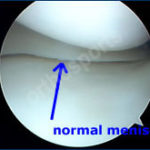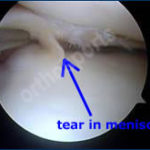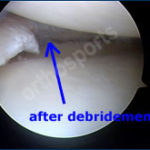Inside This section
Knee Arthroscopy
What Is Arthroscopy?
Arthroscopy involves looking at the inside of the knee joint with a small telescope and camera (arthroscope). The image is projected onto a television monitor via a fibreoptic cable. This modern technique allows the surgeon to fully inspect all of the interior structures of the knee joint without needing open surgery.
Despite the fact that the incisions are quite small, a large amount of surgery can be performed within the knee.
Arthroscopic surgery is usually performed as day surgery (on a ‘day only’ basis).
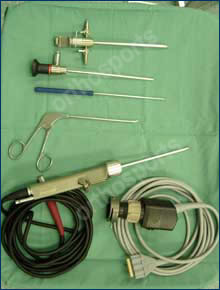

Instruments used and typical setup in the operating theatre
Knee Arthroscopy
Arthroscopic Chondral Shaving
Indications
Meniscal Injury…
Meniscal injury is the most common reason to need an arthroscopy. The meniscus (sometimes known as ‘knee cartilage’) acts as a shock absorber in the knee. The torn part of the meniscus can be a source of pain and further damage to the joint (see Meniscal Tears).
The larger the fragment of meniscus removed the greater the chance of developing arthritis of the knee in the long term. Occasionally in younger patients the meniscus can be repaired. This might require a larger cut if it cannot be done from within the joint. The recovery time is also longer (up to 6 months for complete recovery) and a splint or crutches may be required. The meniscus serves a useful function and we preserve as much of it as possible.
Meniscal tear as seen with an arthroscope, before and after trimming
Articular Cartilage…
Articular cartilage is the smooth lining of the joint which covers the bone. This allows the joint to run smoothly without friction or pain. If the surface becomes rough or irregular it can cause pain and swelling in the knee. This is the earliest form of arthritis. Arthroscopy can help with this but is less reliable than with meniscal tears. An arthroscopy cannot cure arthritis and hence recovery may be less than complete. Occasionally, results in these cases can be disappointing.
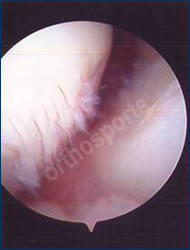
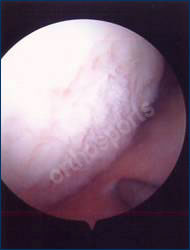
Chondral damage before and after debridement
Loose Bodies…
Loose bodies are loose pieces of cartilage or bone and can occur from a variety of causes. These are removed during arthroscopy.
Diagnosis…
Diagnosis of ligament tears, injury to bone or cartilage (lining of the joint), biopsies or unexplained pain – arthroscopy is useful to assess the inside of the knee to determine the suitability for other surgical procedures.
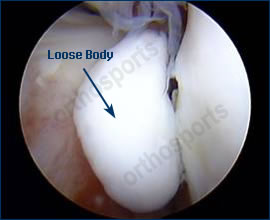
Loose Body
Patella (Knee Cap) Pain…
Patella (knee cap) pain is usually treated by physiotherapy first, as it is a difficult disorder to treat surgically. Occasionally, if there are loose fragments of cartilage behind the kneecap, these can be treated with an arthroscopy.
Another treatment of patella pain is to perform a lateral release. This is a procedure where tight structures pulling the wrong way on your kneecap are released. This has a longer recovery period, and bleeding into the knee is expected. Supervised physiotherapy will almost certainly be required after this operation.
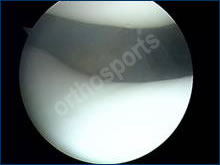
Normal patellofemoral joint
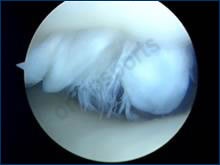
Damaged patella surface
Assessment…
Assessment of suitability for other surgical procedures such as unicondylar knee replacement or osteotomy.
Arthritis…
Arthritis can occasionally be helped by arthroscopy, especially if there are recent mechanical symptoms (i.e. locking, clicking). This is what we regard as a grease and oil change for a knee that will eventually require a knee replacement.
Cruciate Ligament Reconstruction…
See ACL Reconstruction for further information.
Cartilage Biopsy…
If you are a candidate for cartilage transplant, a specimen may be taken at the time of your arthroscopy which may be used at a later time. This may avoid a repeat operation to take a sample of cartilage.
See Cartilage Transfer for further information.
Results
The results from arthroscopic surgery depend on the arthroscopic findings and the underlying condition. In cases of a torn meniscus with no other damage to the joint, the results are usually excellent (There may be a long term tendency towards arthritis since one of the shock absorbers of the joint has been damaged).
Patients who are found to have damage to the articular cartilage (which lines the joint), are likely to continue to experience symptoms. This is due to the underlying nature of the condition and may be intermittent. Patients who have osteoarthritis are unlikely to gain full relief of symptoms following arthroscopic surgery. Arthroscopic surgery in the presence of osteoarthritis can help if the meniscus is torn or there is loose cartilage in the joint but does not affect the underlying condition, which is likely to gradually progress. Occasionally arthroscopic surgery in the presence of osteoarthritis can make symptoms worse for a period of months. Results in these cases are occasionally disappointing with worsening of symptoms but can provide excellent relief for some patients.</p
Exercise
It is useful to do some quadriceps exercises prior to your operation. These exercises are designed to maintain muscle strength of the quadriceps group (which are your front thigh muscles). It is very important to also continue these exercises post-operatively.
Exercise up to the point of mild discomfort is reasonable and is unlikely to cause any damage inside the knee.
Medical History and Medications
We ask that you complete a health questionnaire at the time of your consultation and prior to your operation. We require information about your past and present illnesses, previous operations, current medications and any known allergies.
It is important that you inform us of any change in your medications or health status.
Please take a list of your current medications and known allergies to the hospital on the day of admission and provide this to the anaesthetist, who will see you pre-operatively.
Anti-inflammatory medication such as Aspirin, Orudis, Feldene, Voltaren and Naprosyn should be ceased 10 days prior to surgery as they can cause bleeding. Celebrex and Vioxx may be continued until the day before the procedure.
You are advised to stop smoking for as long as possible prior to surgery.
Cease any naturopathic or herbal medications 10 days before surgery as these can also cause bleeding.
Continue with all other medications unless otherwise specified.
Notify your surgeon if you have any abrasions or pimples around the knee.
Please bring any X-rays, MRI scans or other investigations you have had done which may be relevant to your surgery.
Bring a list of medications with you to give to the anaesthetist.
The operation is usually performed under a general anaesthetic but the final decision rests with the anaesthetist.
You will be admitted to hospital on the day of your operation.
You will need to phone the hospital on the working day prior to you operation to be advised of the admission time to hospital. You will also be given fasting instructions (i.e. you will be told when you must stop eating and drinking before your surgery).
The anaesthetist will see you before your operation. You will need to discuss with the anaesthetist your medical history, current medications and any previous anaesthetic problems. Please feel free to discuss with the anaesthetist the type of anaesthetic that will be used (usually a general anaesthetic) and its possible side effects and complications.
The operation is usually performed under general anaesthesia (i.e. you are asleep). At the end of the procedure the knee is injected with long acting local anaesthetic to keep pain to a minimum.
After Surgery
The physiotherapist will also visit you in the ward after surgery. You will be shown some exercises to do. If crutches are required they will be supplied by the hospital physiotherapist.
You may exercise at home up to the point of mild discomfort. This is unlikely to cause any damage to your knee. Avoid deep squats, kneeling and spending too much time on your feet in the first few days after surgery. It is important to keep the leg elevated as much as possible in the days following surgery.
It is normal for some blood to collect under the dressings. It is also normal for the knee to develop some bruising after surgery.
You will be provided with pain killers to take home with you.
If you are taking regular anti-inflammatory medications, you may resume these after surgery.
It is not permitted to drive a motor vehicle for 24 hours after having a general anaesthetic. You will therefore need to arrange other transport home from the hospital. It is best to go home with a relative or a friend. You can resume driving only when your knee is comfortable and you have no restrictions in operating your vehicle.
It is recommended that you do not travel long distances by car or plane for at least two and preferably six weeks following surgery as prolonged travel can increase the risk of forming blood clots in the leg.
Post-Operative Appointment
We will need to see you in the office about 10 days after surgery.
Return To Work
You may return to work as your knee function improves well enough for you to do your particular job. This does not mean that all discomfort must have resolved, as there will be some tenderness around the incision sites. It is normal for there to be some discomfort in the knee for several weeks after arthroscopic surgery. We will provide you with a medical certificate at your first post-operative visit if required.
Recovery from this operation involves reducing the swelling, strengthening the muscles and reducing pain.
Reduce Pain
Excessive pain in the knee following arthroscopic surgery is usually due to overactivity or spending too much time on your feet before the thigh muscles have been adequately strengthened. Excessive swelling can also cause pain in the knee.
It is normal for the knee to be sore and swollen following arthroscopy. Activity should be increased gradually. You should avoid prolonged walking or standing for the first few days. You should avoid squatting or kneeling or attempting to bend your knee beyond 90 degrees if the knee is painful or swollen.
Reduce Swelling
Keep the leg elevated as much as possible after the operation. Apply an ice pack to the knee for 30 minutes at a time to reduce swelling and pain. Anti-inflammatory medications can also be helpful in reducing swelling. Initially the ice packs should be placed on the bandages and then when the dressing has been reduced ensure that you place a cloth between your skin and the ice pack to prevent an ice burn.
Quadriceps Strengthening Exercises
Strengthening your quadriceps is important in restoring function to the knee.
The physiotherapist at the hospital will have shown you how to do these exercises. You should continue them on a regular basis for several weeks after the operation.
Following surgery, you will wake up in recovery with your knee bandaged. Most patients will go home on the day of surgery, but some may require an overnight stay. You will require pain killers and may have crutches to go home. You should make arrangements to get home, as you will not be able to drive.
You will usually be seen before you go home to explain the results of the operation. This will be further discussed at your follow up visit.
Complications
Any surgical procedure has a risk of complications. These are rare with an arthroscopy, however they can occur. Every precaution is taken to minimise the risk. Complications can be related to the anaesthetic, general in nature it can happen with any surgery or be specific to knee arthroscopy.
Summary
Arthroscopy of the knee is a safe and effective procedure. Remember that every knee is unique, and recovery time and the results of the procedure reflect this. Complications are rare but can occur. If you have further questions regarding your surgery, please ask before your operation.

